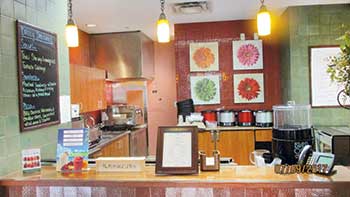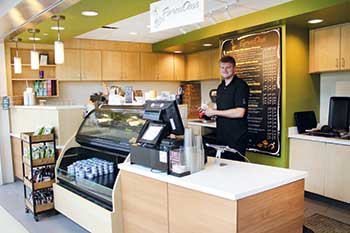Balancing customer satisfaction and the bottom line means operators walk a tightrope as they apply a cornucopia of ingenious solutions to persistent challenges.
 Quick-dining concept The Café at The Garlands has a high-speed oven that allows staff to prepare freshly made menu items such as pizza with house-made dough in 90 seconds and a salmon entree in fewer than 5 minutes. Photo courtesy of The GarlandsA cloud of uncertainty blankets the healthcare landscape as Congress determines how — or whether — to revise the Affordable Care Act. Regardless of the outcome, hospital and long-term care executives must anticipate possible worst-case financial scenarios that could come about as a result of further healthcare system consolidations, Medicaid reimbursement reductions, and higher operating costs for staff and supplies. Executives' responses include reducing operating expenses while driving initiatives to continually improve patient safety, quality of care and satisfaction. In areas with low unemployment rates, finding ways to recruit and retain employees also tops the lists of challenges.
Quick-dining concept The Café at The Garlands has a high-speed oven that allows staff to prepare freshly made menu items such as pizza with house-made dough in 90 seconds and a salmon entree in fewer than 5 minutes. Photo courtesy of The GarlandsA cloud of uncertainty blankets the healthcare landscape as Congress determines how — or whether — to revise the Affordable Care Act. Regardless of the outcome, hospital and long-term care executives must anticipate possible worst-case financial scenarios that could come about as a result of further healthcare system consolidations, Medicaid reimbursement reductions, and higher operating costs for staff and supplies. Executives' responses include reducing operating expenses while driving initiatives to continually improve patient safety, quality of care and satisfaction. In areas with low unemployment rates, finding ways to recruit and retain employees also tops the lists of challenges.
Healthcare executives call on foodservice directors and their teams to find solutions to these challenges. Foodservice teams may have thought they had reached as deep as they could into their creativity to find solutions to similar challenges in the past. But in this current environment, they face more pressure than ever to reassess — again and again — every aspect of their operational strategies to respond to their administrators' requests.
"Foodservice operators must be very astute and flexible to assess moment to moment what's needed and appropriate in their environments," says Paul Hysen, principal for the Hysen Group, a Northville, Mich.-based foodservice consulting firm. "They also must be ready to take immediate action to make changes."
Strategies directors apply to meet the administration's mandates reach far into all facets of their department, which often include patient services, retail operations and labor management. Regardless of the changes made, "focusing on customer service and being able to assess its effectiveness continues to be the driving force in health care foodservice," says Georgie Shockey, president, Ruck-Shockey Associates Inc., The Woodlands, Texas.
 Consultant and executive chef Joe Beato displays pasta dishes for staff to taste at Eastern Maine Medical Center’s new cafe."A successful approach to continuously improving customer service is through customization," adds Scott T. Reitano, principal, Reitano Design Group in Indianapolis. "Customization is necessary for all facets of a foodservice department from patient and retail meal programs, catering, labor management, and wellness and sustainable initiatives. Many directors are bringing in chefs who work closely with dietitians to provide this customization and upgrade the menu quality for all operations."
Consultant and executive chef Joe Beato displays pasta dishes for staff to taste at Eastern Maine Medical Center’s new cafe."A successful approach to continuously improving customer service is through customization," adds Scott T. Reitano, principal, Reitano Design Group in Indianapolis. "Customization is necessary for all facets of a foodservice department from patient and retail meal programs, catering, labor management, and wellness and sustainable initiatives. Many directors are bringing in chefs who work closely with dietitians to provide this customization and upgrade the menu quality for all operations."
While foodservice teams work to customize services that work best in their environments, whatever is done to satisfy external and internal (i.e., employees) customers must also be cost-effective.
Patient Foodservice
"In patient foodservice, for instance, room service works well for some healthcare systems, while others find greater success balancing customer satisfaction with cost containment using a pod system or a hybrid of the two systems," says Tom Cooley, MA, RD, LDN, principal of TCB Partners in Quakertown, Pa. Staffing, elevator access, funding to refurbish the kitchen with the right equipment, nurses and other hospital staff's approval, and patients' ability to order menu items all influence the decisions that surround patient foodservice.
For example, Baptist Health Medical Center in Arkansas converted its three largest facilities to room service a year ago. The change required extensive renovation in the kitchens and the purchase of new equipment. "Our food cost spend has decreased, while at the same time, our patient satisfaction scores are increasing," says Becky Blackard, RD, LD, system operations manager for Nutrition and Foodservice, at Baptist Health. "We have seen positive outcomes. The morale of the department is up because the staff members are very proud of the product that we are serving our patients."
UCLA Health System in Los Angeles uses its Signature Dining program, a hotel-style approach to room service, to serve patients at Ronald Reagan UCLA Medical Center and Mattel Children's Hospital. In the planning stage, 24-hour service seemed like the best approach to take to satisfy customers, but in reality, 13½ hours has proven sufficient. "We realized it wasn't worthwhile to employ staff after 7:30 p.m. due to the lower volume," says Patti Oliver, MS, RDN, MBA, director of Nutrition, UCLA Health.
 Seth Jones, a student at Ohio State, prepares coffee drinks at EspressOasis, one of several leased operations at Ohio State University Wexner Medical Center. Photo courtesy of OSUWMC; photograph by Drew Patterson, CEC, CCAAs a result, Signature Dining's room service operates between 6:45 a.m. and 7:30 p.m. Trayed food arrives on floors from the kitchen via food lifts to floor pantries. Ambassadors on the floors place ice cream and coffee on trays and serve patients within 45 minutes of their meal orders. To provide more personalized attention to patients, staff work three 13-hour days. "Patients have the same servers for all three meals, which they appreciate," Oliver adds.
Seth Jones, a student at Ohio State, prepares coffee drinks at EspressOasis, one of several leased operations at Ohio State University Wexner Medical Center. Photo courtesy of OSUWMC; photograph by Drew Patterson, CEC, CCAAs a result, Signature Dining's room service operates between 6:45 a.m. and 7:30 p.m. Trayed food arrives on floors from the kitchen via food lifts to floor pantries. Ambassadors on the floors place ice cream and coffee on trays and serve patients within 45 minutes of their meal orders. To provide more personalized attention to patients, staff work three 13-hour days. "Patients have the same servers for all three meals, which they appreciate," Oliver adds.
Though Antoinette "Toni" Watkins, MS, RDN, system director of Food & Nutrition Service, would like to implement room service in acute-care facilities at Virginia-based Riverside Health System, the current patient foodservice system uses a spoken-menu approach in which ambassadors use tablets to take patients' menu orders. "This gives personalized service, which is working well," Watkins says. For cost efficiencies, Watkins and her team have streamlined purchasing while developing a managed order guide with pre-approved and substitution food items that the team will use in late 2017.
Retail Opportunities
"In many healthcare operations, retail is a missed opportunity to build revenue and increase customer satisfaction," says Angelo Mojica, PhD, RD, CEC, system director of Food and Culinary Services at Johns Hopkins Medicine in Baltimore. "A revenue-generating retail operation can offset costs in other operations, such as patient services and costs of buying locally sourced foods."
Improving customer satisfaction and increasing potential revenue also top the list of goals at a new cafe at Eastern Maine Medical Center (EMMC) in Bangor, Maine. The cafe features made-to-order menu items such as pasta dishes and rotisserie chicken, meats and vegetables. Valerie Langbein, director, Nutrition Services, insists on not confusing a made-to-order philosophy with a large menu that's difficult to manage. It's quite the opposite at EMMC.
"It's very tempting to try to be all things to all people and provide them with everything they ask for," Langbein says. "That approach usually backfires, despite good intentions. It's more important to lead customers to foods we do very well, foods that consistently taste great, look great and serve beautifully." Staff satisfaction also rises as they see their customers' appreciation of their cooking.
Expanding retail operations works well for increasing customer satisfaction and bringing in revenue at Ohio State University Wexner Medical Center (WexMed). Julie Jones, MS, RD, LD, director of Nutrition Services, and her staff self-operate 11 retail cafes — 2 full-service BistrOH! sites, 7 BistrOH! To Go sites, 1 Bloch Café and 1 Neuro BistrOH! — in a variety of medical center locations. In addition, Nutrition Services provides oversight and key support for subcontracted food operations that lease space from WexMed, which include Au Bon Pain (company owned), Wendy's (local franchisee), 3 EspressOasis coffee service locations (company owned) and Cheryl's Cookies (company owned). Nutrition Services also coordinates a gourmet mobile food truck and carts that sell food at a variety of off-campus locations. These operations provide additional revenue to Nutrition Services' retail foods program, and many remain open after traditional hours to provide services.
While building their retail business, several hospital foodservice operators also use portions of their display kitchen space for skills-based training for hospital employees and community members. Digital screens display chefs' actions captured by video cameras set up at stations. Dietitians often contribute nutrition advice during these presentations. "We're seeing healthcare dining facilities become more experience-oriented, similar to operations in higher education and corporate dining," says Kathleen H. Seelye, FFCSI, LEED AP, CEO, Ricca Design Studios in Greenwood Village, Colo. "In addition to opening their facilities for skills-based training, healthcare foodservices are reaching out into the communities to educate people about food as medicine and how to practice preventative care. In the future, medical services and foodservices aren't going to be limited to hospitals and doctors' offices. They will be part of the urban and suburban environment."
Foodservice for Long-Term Care
Foodservice directors at long-term care and senior living facilities must also keep customizing their dining operations and selections while offering a variety of food options to keep residents satisfied. Like other parts of the health care foodservice industry, cost control is important here, too.
At The Garlands in Barrington, Ill., residents can choose between four restaurants and a cafe, each with a distinctive menu that pleases senior residents. Director of Hospitality Istvan Abdai and his team also offer chef-catered meals at home for residents in the independent living area. Residents who belong to The Garlands Wine Club visit local wineries, enjoy monthly tastings and learn about pairing wines with food.
At Pennswood Village in Newtown, Pa., exhibition cooking proves successful in promoting interaction between the residents and culinary staff. "We are taking our action station in the main dining room and moving it to other dining rooms as well to encourage a higher level of engagement among residents and staff," says Mary Cooley, LDN, director of Dining Services.
Several best practice stories illustrate how healthcare foodservice directors and their teams are responding to challenges to balance customer satisfaction and cost-effectiveness. Foodservice equipment supports their goals to improve menu quality, reduce labor and increase staff efficiency, and contribute to sustainable practices.



